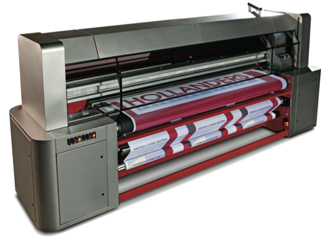Nessan Cleary takes a closer look at this range of printers, with which Hollanders continues to single-mindedly pursue the textile market.
Dutch manufacturer Hollanders was set up in 2003 specifically to make large-format textile printers. Almost uniquely, Hollanders has opted to concentrate its efforts at the communications market, including soft signage, rather than the growing garment industry.
These machines are big and fairly expensive but are designed to be production workhorses, running 24 hours a day, seven days a week. Indeed, the first machine, installed way back in 2003 is still running, testament to its solid engineering.
That original model, the 230, has now been replaced by the slightly larger 250 with its 2.5m print width. There’s a larger model still, the XL, which has a print width of 3.2m and Hollanders has just launched a double sided printer, the DS, which is essentially two of the XL print engines put together, with a built-in IR fixation unit. All of the machines have the same basic engineering, so that the specifications mostly apply across the board.
Hollanders has taken an extremely flexible approach in its use of printheads. The 250 has Ricoh Gen5 heads as standard, while the XL uses the Seiko 508GS. Marketing manager Roland Biemans says that the difference is down to the minimum dot size - 6pl for the Ricohs versus 12pl for the Seiko heads - with the smaller drop size being better for fine art work while the Seiko’s are targeted at higher productivity. However, customers can specify to have either head, and those heads can be changed at a later date if so desired.
Also, customers can choose to have four or six colours. Biemans says that the four-colour machines ship with the cleaning stations for all six colours so it’s a relatively simple field-upgrade to add the extra colours later.
There’s a choice of inks, depending on the target application. This includes a low energy dye sublimation inkset, which is best used for indoor applications as it can be prone to fading over time. There’s also a high energy disperse direct ink, which is similar but with a slightly different molecular structure. These inks can be printed direct to textile and can be finished with a choice of IR fixation, calendering or steaming, with Hollanders supplying the appropriate units.
The printers can also be used for dye-sublimation via transfer paper, though this needs to go through a calender. There’s also an acid reactive ink that is suitable for materials such as nylon, though this can only be dried via steaming and has to be washed.
Biemans says that the machines have been designed to run with the least amount of operator intervention, and the least amount of waste, noting: “We have built the machines as reliably as possible”. They are highly automated with automatic cleaning that can be set to clean after so many metres or a certain number of jobs have been printed. They also have built in air conditioning to control the temperature and humidity within the printers.
Hollanders has developed its own Rip, which works on a client/server architecture so that the prepress and machine operating functions are separated. The prepress element includes preflighting from Enfocus as well as colour management and soft proofing. It also includes recipes for producing Pantone colours on various textiles, which can be tweaked by the operators as necessary.
Finally, it’s worth noting that there are two Webcams built into the machines, and a remote support system so that Hollander’s engineers can assess problems before sending out an engineer. Customers can take out a service level agreement, which includes twice-yearly preventative maintenance and priority emergency support.


